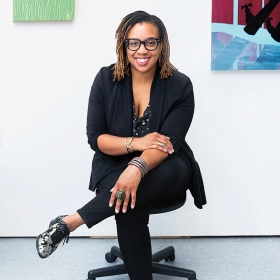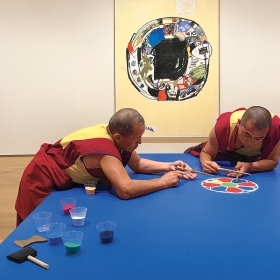Alexandria Smith, assistant professor of studio art, is animated by the desire to tell more than one story, especially about people of color. “Visual art and media are critical in shaping the ways we view others,” she says.

Photo by Lachell Workman
Alexandria Smith’s life, like her exuberant collages, is composed of many layers. She’s a mixed-media visual artist, assistant professor of studio art at Wellesley, the co-organizer of the artists’ collective Black Women Artists for Black Lives Matter, and a former art teacher in the New York City schools.
Her art deals with questions of identity, of “trying to figure out who you are,” she says. Earlier in her career, Smith created characters who are young black girls in pigtails and dresses. In a series of paintings and drawings, these cartoonish figures are often shown with a paper sack or pillowcase over their heads. Smith explains that these characters “evoke various psychological states, and at the same time blur the distinction between representation and abstraction.”
The works delve into not only the common experience of being an adolescent, and a girl, but more particularly, being an adolescent girl of color. Smith says that while she drew from her own life, none of the work should be taken as autobiographical. She’s more interested in the complexity and totality of female experience.
A theme that runs throughout her work is the journey of girls becoming women, and how they develop a sense of self and a feeling of empowerment along the way. “I’m trying to highlight multiple aspects of femininity,” she says.
In Smith’s more recent work, the girls in pigtails appear to have grown up. In The Pleasure Principle, a 10-by-40-foot paper and canvas collage, women’s bodies are depicted in full bloom, as they cavort and enjoy themselves every bit as much as the women in Cézanne’s The Bathers. The analogy is intentional: Smith’s compositions often reference historic paintings from the impressionist, Baroque, and Renaissance eras. She’s commenting on the idealized view of (white) women found in paintings throughout history. “I wanted to showcase black and brown figures just being joyful and happy and present and seen,” she says.
‘The goal of my work is to amplify the voices of marginalized people through the visual arts.’
— Alexandria Smith, assistant professor of art
Smith is animated by the desire to tell more than one story, especially about people of color. “Visual art and media are critical in shaping the ways we view others,” she says. “There needs to be greater representation and visibility of everyone, and their stories told, so we don’t have this unilateral way of looking at things. When it’s only one story, that’s what leads to the problems we’re having in the world now.”
She describes the goal of her work as “amplifying the voices of the marginalized.” She does this through many avenues: making and teaching art, advocating for arts education, and taking part in Black Women Artists for Black Lives Matter. Smith explains that the collective was formed as a response to the deaths of black people at the hands of police. “We felt paralyzed,” she says. “We were all asking how we could use our creativity to highlight these injustices.” The collective, begun in 2016, is gaining visibility, and its members have staged exhibitions and performances in cities such as New York, Houston, Los Angeles, and London.
Smith has been involved with education since the age of 16, when she coached soccer. In 2005, while finishing a master’s degree in art education at New York University, she taught at the Harlem Children’s Zone Promise Academy Charter School. Later, she taught middle school in East Harlem and high school in the South Bronx, and completed an M.F.A. in painting and drawing at Parsons|The New School. While she loved the students she taught, she disliked the emphasis on high test scores, which left little time for art and creativity.
“Students learn compassion, tenderness, and humanity through the arts, which is integral to breaking down barriers and instigating social change,” she says.

